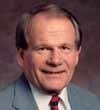I grew up outside of the Church, in a small town in South Texas. My father was a professor at the local university. Though I was baptized at age eight, there were no Latter-day Saints in that area, so I attended the Methodist Church until my parents divorced just before my fifteenth birthday. My mother and I moved into Mormondom—Logan, Utah—where I began high school. Not used to giving talks in church, I avoided any involvement that could require my having to speak, and was successful. Following high school, I went into the military for a six-month program beginning at Ft. Ord, California. During a stake conference there, two presiding church officers spoke and I was impressed enough to get serious about the Church and serve a mission. I figured that if I was going to belong to a ‘lay’ church, I ought to know something about its teachings. However, I had never read the Book of Mormon, so was at a disadvantage right off the bat. However, there was a missionary study program where you had to answer questions on paper relative to what you read, so I went to work on them. One impressive thing I learned came from 1 Nephi 1:4, where Nephi explained the time frame: “in the commencement of the first year of the reign of Zedekiah, king of Judah. . . and in that same year there came many prophets, prophesying unto the people that they must repent, or the great city Jerusalem must be destroyed.” I noticed a cross reference at the bottom of the page to 2 Chronicles 36:15-16 (actually verses 11-16 was more complete.) I was stunned to think that a young man, Joseph Smith, at age 22, would know who Zedekiah was, much less know about prophets who called the Jerusalemites to repentance. Then, reading about the Jaredites who came at the time of the tower of Babel, I read Genesis 11:7-9. I knew that the Book of Mormon was a true record of at least two civilizations. It became the basis of my initial testimony.
Later, I read where Elder Bruce R. McConkie said: “There is another and simpler test that all who seek to know the truth might well take. It calls for us simply to read, ponder, and pray—all in the spirit of faith and with an open mind. To keep ourselves alert to the issues at hand—as we do read, ponder, and pray—we should ask ourselves a thousand times, ‘Could any man have written this book?’ And it is absolutely guaranteed that sometime between the first and [last] time this question is asked, every sincere and genuine true seeker will come to know by the power of the Spirit that the Book of Mormon is true, that it is the mind and will and voice of the Lord to the whole world in our day.”
President Ezra Taft Benson spanked the church for not reading the Book of Mormon (based on Doctrine and Covenants 84:54-57). It was clear to me what he was saying: ‘If the Book of Mormon is true, then Joseph Smith must be a prophet; and if he is a prophet of God, then the Church he established must be the Lord’s Church.’ That logic has stayed with me and can be applied to the other standard works of the Church. This work is of God. I know that to be true.
As I have had a chance to study the gospel and teach it over the years, I have come to appreciate the contribution of Joseph Smith. I believe that he has revealed more concerning the gospel of Jesus Christ in our day than has been revealed since the days of Adam. His Joseph Smith Translation, for example, solved so many mysterious passages in the Bible and has made the Bible come alive. Isaiah 29:10-14 comes to mind, as does Ezekiel 37:15-20. In return, the Book of Mormon testifies of the Bible (see 1 Nephi 13:38-42).
As I have studied the doctrines and teachings of other churches, it is apparent that a restoration was needed, and I know that Joseph Smith was that instrument in the hands of the Lord to bring that very thing about in these ‘latter days.’
Posted May 2010 on FairMormon.org

Douglas E. Brinley graduated in economics from Utah State University, obtained a master’s degree from Utah State, and later received a Ph.D from Brigham Young University in family studies. He has authored or co-authored ten books, nine of which are on marriage and family relations, including Between Husband & Wife: Gospel Perspectives on Marital Intimacy, First Comes Love (for those preparing for marriage), the sequel Then Comes Marriage, and Living a Covenant Marriage. The non-marriage book is America in Peril, which concerns the past, present, and future of America from a Book of Mormon perspective. He also has a marriage DVD entitled Relationships Seminar, from Covenant Communications. He taught at Brigham Young University in the College of Religious Education and the Department of Church History and Doctrine. He retired in 2008 after forty-three years in Church Education, the last eighteen years at Brigham Young University.